
The Amazing Spider-Man is an ongoing American superhero comic book series featuring the Marvel Comics superhero Spider-Man as its title character and main protagonist. Being in the mainstream continuity of the franchise, it began publication in 1963 as a bimonthly periodical, quickly being increased to monthly, and was published continuously, with a brief interruption in 1995, until its second volume with a new numbering order in 1999. In 2003, the series reverted to the numbering order of the first volume. The title has occasionally been published biweekly, and was published three times a month from 2008 to 2010.

Spider-Man is a superhero appearing in American comic books published by Marvel Comics. Created by writer-editor Stan Lee and artist Steve Ditko, he first appeared in the anthology comic book Amazing Fantasy #15 in the Silver Age of Comic Books. He has been featured in comic book, television shows, films, video games, novels, and plays. Spider-Man's secret identity is Peter Parker, a teenage high school student and an orphan raised by his Aunt May and Uncle Ben in New York City after his parents Richard and Mary Parker died in a plane crash. Lee and Ditko had the character deal with the struggles of adolescence and financial issues and gave him many supporting characters, such as Flash Thompson, J. Jonah Jameson, and Harry Osborn; romantic interests Gwen Stacy, Mary Jane Watson, and the Black Cat; and his enemies such as the Green Goblin, Doctor Octopus, and Venom. In his origin story, Spider-Man gets his superhuman spider-powers and abilities after being bitten by a radioactive spider; these include clinging to surfaces and ceilings, superhuman strength, speed, agility, jump, reflexes, stamina, and detecting danger with his precognition ability called "spider-sense." He also builds wrist-mounted "web-shooter" devices that shoot artificial spider-webs of his own design that were meant to be used for fighting his enemies and web-swinging across the city. Peter Parker originally used his powers for his own personal gain, but after his Uncle Ben was killed by a thief that Peter didn't stop, Peter begins to use his spider-powers to fight crime by becoming the superhero known as Spider-Man.

Stephen John Ditko was an American comics artist and writer best known for being co-creator of Marvel superhero Spider-Man and creator of Doctor Strange. He also made notable contributions to the character of Iron Man with the character's iconic red and yellow design being revolutionized by Ditko.
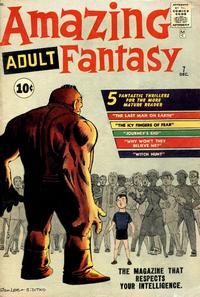
Amazing Adult Fantasy, retitled Amazing Fantasy in its final issue, is an American superhero comic book anthology series published by Marvel Comics from 1961 through 1962, with the latter title revived with superhero features in 1995 and in the 2000s. The final 1960s issue, Amazing Fantasy #15, introduced the popular superhero character Spider-Man. Amazing Adult Fantasy premiered with issue #7, taking over the numbering from Amazing Adventures.

Gerard Francis Conway is an American comic book writer, comic book editor, screenwriter, television writer, and television producer. He is known for co-creating the Marvel Comics vigilante antihero the Punisher as well as the Scarlet Spider, and the first Ms. Marvel, and also scripting the death of the character Gwen Stacy during his long run on The Amazing Spider-Man. At DC Comics, he is known for co-creating the superheroes Firestorm and Power Girl, the character Jason Todd and the villain Killer Croc, and for writing the Justice League of America for eight years. Conway wrote the first major, modern-day intercompany crossover, Superman vs. the Amazing Spider-Man.
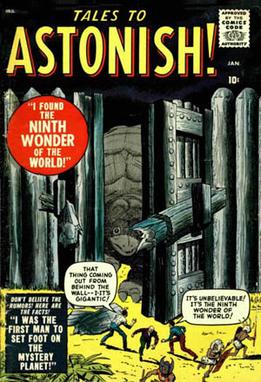
Tales to Astonish is the name of two American comic book series and a one-shot comic published by Marvel Comics.
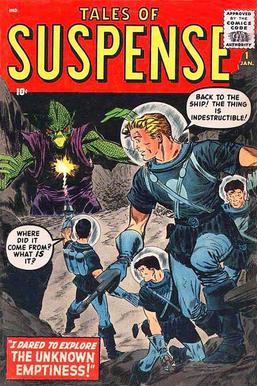
Tales of Suspense is the name of an American comic book anthology series and two one-shot comics published by Marvel Comics. The first, which ran from 1959 to 1968, began as a science-fiction anthology that served as a showcase for such artists as Jack Kirby, Steve Ditko, and Don Heck, then featured superheroes Captain America and Iron Man during the Silver Age of Comic Books before changing its title to Captain America with issue #100. Its sister title was Tales to Astonish. Following the launch of Marvel Legacy in 2017, Tales of Suspense was once again resurrected at issue #100, featuring the Winter Soldier and Hawkeye in a story called "The Red Ledger".
Amazing Adventures is the name of several anthology comic book series, all but one published by Marvel Comics.
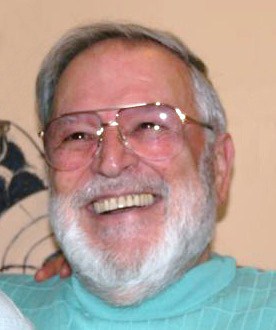
John V. Romita is an American comic book artist best known for his work on Marvel Comics' The Amazing Spider-Man and for co-creating characters including the Punisher and Wolverine. He was inducted into the Will Eisner Comic Book Hall of Fame in 2002. Romita is the father of John Romita Jr., also a comic book artist and husband of Virginia Romita, for many years Marvel's traffic manager.

John Salvatore Romita, known professionally as John Romita Jr., is an American comics artist best known for his extensive work for Marvel Comics from the 1970s to the 2010s. He is the son of artist John Romita Sr.

Donald L. Heck was an American comics artist best known for co-creating the Marvel Comics characters Iron Man, the Wasp, Black Widow, Hawkeye and Wonder Man and for his long run penciling the Marvel superhero-team series The Avengers during the 1960s Silver Age of comic books.
Ronald Wade Frenz is an American comics artist known for his work for Marvel Comics. He is well known for his 1980s work on The Amazing Spider-Man and later for his work on Spider-Girl whom he co-created with writer Tom DeFalco. Frenz and DeFalco had earlier co-created the New Warriors in the pages of Thor.
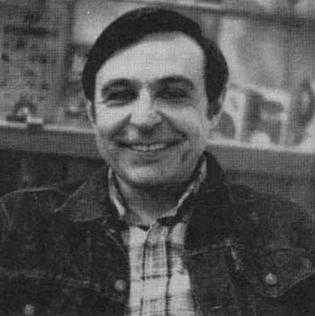
Ross Andru was an American comics artist and editor whose career in comics spanned six decades. He is best known for his work on The Amazing Spider-Man, Wonder Woman, The Flash, and The Metal Men, and for having co-created the character called The Punisher.

The Spectacular Spider-Man is a comic book and magazine series starring Spider-Man and published by Marvel Comics.
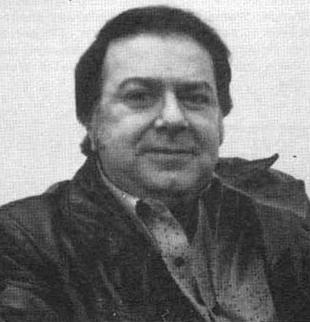
Mike Esposito, who sometimes used the pseudonyms Mickey Demeo, Mickey Dee, Michael Dee, and Joe Gaudioso, was an American comic book artist whose work for DC Comics, Marvel Comics and others spanned the 1950s to the 2000s. As a comic book inker teamed with his childhood friend Ross Andru, he drew for such major titles as The Amazing Spider-Man and Wonder Woman. An Andru-Esposito drawing of Wonder Woman appears on a 2006 U.S. stamp.
Marvel Fireside Books were a series of full-color trade paperbacks featuring Marvel Comics stories and characters co-published by Marvel and the Simon & Schuster division Fireside Books from 1974 to 1979. The first book, 1974's Origins of Marvel Comics, was very successful, and inspired a series of annual sequels.

Fantastic Four is the name of several comic book titles featuring the team Fantastic Four and published by Marvel Comics, beginning with the original Fantastic Four comic book series which debuted in 1961.
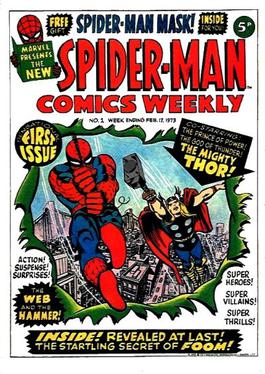
Spider-Man Comics Weekly was a Marvel UK publication which primarily published black-and-white reprints of American Marvel four-color Spider-Man stories. Marvel UK's second-ever title, Spider-Man Comics Weekly debuted in 1973, initially publishing "classic" 1960s Spider-Man stories.
Marvel Treasury Edition is an American comic book series published by Marvel Comics from 1974 to 1981. It usually featured reprints of previously published stories but a few issues contained new material. The series was published in an oversized 10" x 14" tabloid format and was launched with a collection of Spider-Man stories. The series concluded with the second Superman and Spider-Man intercompany crossover. Marvel also published treasuries under the titles Marvel Special Edition and Marvel Treasury Special as well as a number of one-shots.
















